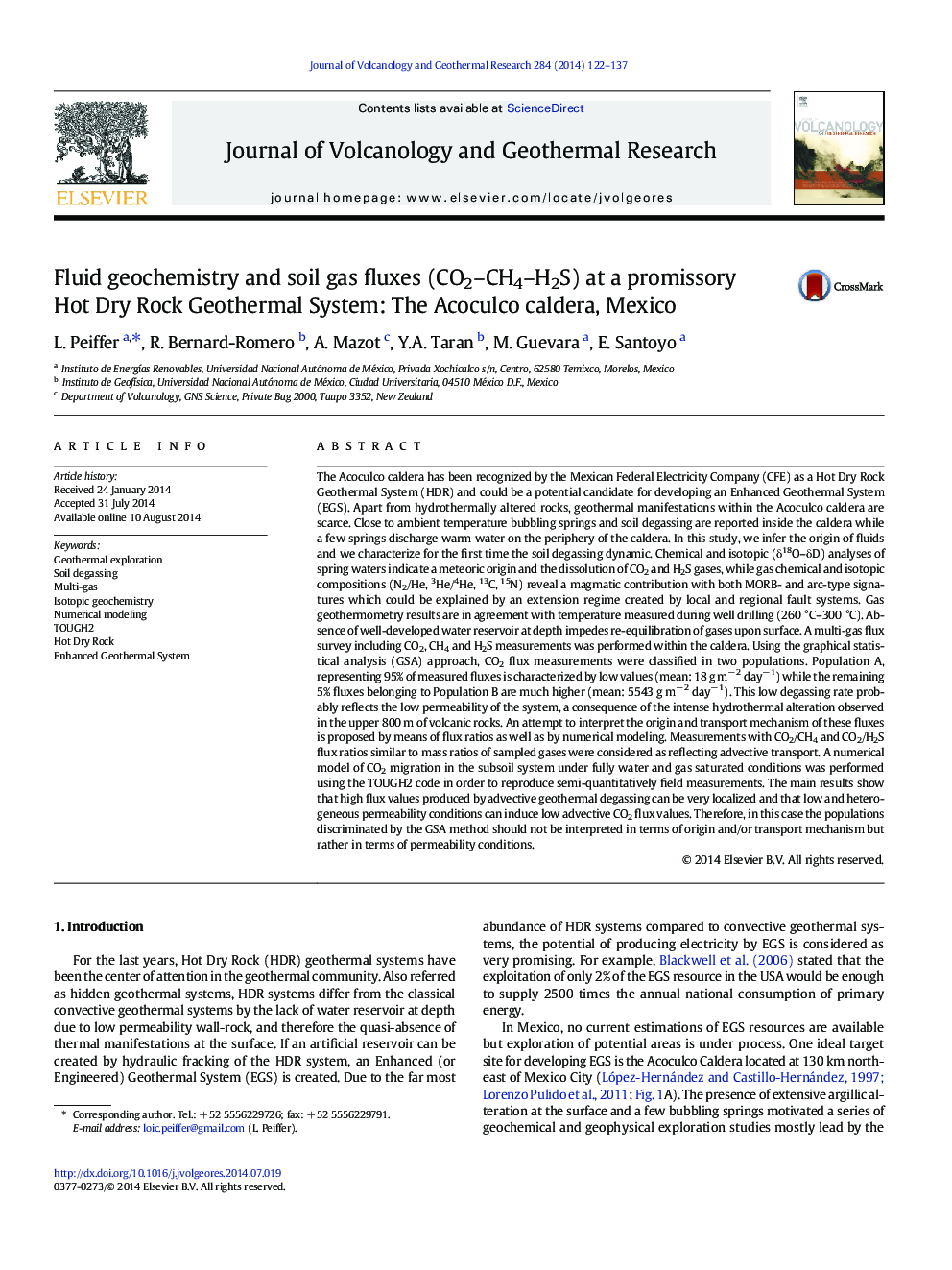| کد مقاله | کد نشریه | سال انتشار | مقاله انگلیسی | نسخه تمام متن |
|---|---|---|---|---|
| 4713103 | 1638338 | 2014 | 16 صفحه PDF | دانلود رایگان |

• Acoculco caldera is a promissory Hot Dry Rock Geothermal System.
• Spring water compositions indicate mainly a meteoric origin.
• Gas compositions reveal both MORB- and arc-type signatures.
• Absence of water reservoir at depth is caused by a low permeability caprock.
• Geothermal CO2 degassing is limited due to the low permeability of the rocks.
• Numerical model shows that geothermal advective flux anomalies can be very localized.
• Low advective CO2 fluxes can show values similar to biogenic ones.
The Acoculco caldera has been recognized by the Mexican Federal Electricity Company (CFE) as a Hot Dry Rock Geothermal System (HDR) and could be a potential candidate for developing an Enhanced Geothermal System (EGS). Apart from hydrothermally altered rocks, geothermal manifestations within the Acoculco caldera are scarce. Close to ambient temperature bubbling springs and soil degassing are reported inside the caldera while a few springs discharge warm water on the periphery of the caldera. In this study, we infer the origin of fluids and we characterize for the first time the soil degassing dynamic. Chemical and isotopic (δ18O–δD) analyses of spring waters indicate a meteoric origin and the dissolution of CO2 and H2S gases, while gas chemical and isotopic compositions (N2/He, 3He/4He, 13C, 15N) reveal a magmatic contribution with both MORB- and arc-type signatures which could be explained by an extension regime created by local and regional fault systems. Gas geothermometry results are in agreement with temperature measured during well drilling (260 °C–300 °C). Absence of well-developed water reservoir at depth impedes re-equilibration of gases upon surface. A multi-gas flux survey including CO2, CH4 and H2S measurements was performed within the caldera. Using the graphical statistical analysis (GSA) approach, CO2 flux measurements were classified in two populations. Population A, representing 95% of measured fluxes is characterized by low values (mean: 18 g m− 2 day− 1) while the remaining 5% fluxes belonging to Population B are much higher (mean: 5543 g m− 2 day− 1). This low degassing rate probably reflects the low permeability of the system, a consequence of the intense hydrothermal alteration observed in the upper 800 m of volcanic rocks. An attempt to interpret the origin and transport mechanism of these fluxes is proposed by means of flux ratios as well as by numerical modeling. Measurements with CO2/CH4 and CO2/H2S flux ratios similar to mass ratios of sampled gases were considered as reflecting advective transport. A numerical model of CO2 migration in the subsoil system under fully water and gas saturated conditions was performed using the TOUGH2 code in order to reproduce semi-quantitatively field measurements. The main results show that high flux values produced by advective geothermal degassing can be very localized and that low and heterogeneous permeability conditions can induce low advective CO2 flux values. Therefore, in this case the populations discriminated by the GSA method should not be interpreted in terms of origin and/or transport mechanism but rather in terms of permeability conditions.
Journal: Journal of Volcanology and Geothermal Research - Volume 284, 1 September 2014, Pages 122–137